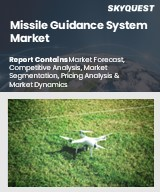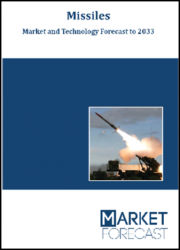
|
시장보고서
상품코드
1755472
미사일 유도 시스템 시장 규모, 점유율, 성장 분석, 유형별, 미사일 유형별, 용도별, 유도 시스템별, 지역별 - 산업 예측(2025-2032년)Missile Guidance System Market Size, Share, and Growth Analysis, By Type (Optical Guidance, Inertial Guidance), By Missile Type (Surface-to-Air Missiles, Air-to-Air Missiles), By Application, By Guidance System, By Region - Industry Forecast 2025-2032 |
||||||
미사일 유도 시스템 세계 시장 규모는 2023년에 9억 달러, 2024년 9억 6,000만 달러에서 2032년에는 16억 4,000만 달러로 성장하고, 예측 기간(2025-2032년) CAGR은 6.9%를 나타낼 전망입니다.
세계 미사일 유도 시스템 시장은 미사일 기술 개발에 대한 관심 증가에 힘입어 큰 폭으로 성장하고 있습니다. 유도 기술의 지속적인 발전으로 미사일 공격의 정확도와 효율성이 향상되고 있습니다. 주요 혁신 기술로는 관성항법시스템(INS), 전지구측위시스템(GPS), 레이저 유도 시스템, 터미널 호밍 시스템 등이 있습니다. 이러한 기술들이 연동되어 미사일은 지정된 목표 좌표로 직접 항해하고, 비행 중 궤도를 조정하고, 이동하는 목표물을 정확하게 포착할 수 있습니다. 군사 및 방위 부문이 공격 능력의 정확성을 점점 더 우선시함에 따라 첨단 미사일 유도 시스템에 대한 수요가 증가할 것으로 예상되며, 이는 시장 진출기업들에게 혁신과 확장의 충분한 기회를 제공합니다.
목차
서론
- 조사 목적
- 조사 범위
- 정의
조사 방법
- 정보 조달
- 2차와 1차 데이터 방법
- 시장 규모 예측
- 시장 전제조건과 제한
주요 요약
- 세계 시장 전망
- 공급과 수요 동향 분석
- 부문별 기회 분석
시장 역학과 전망
- 시장 개요
- 시장 규모
- 시장 역학
- 성장 촉진요인과 기회
- 성장 억제요인과 과제
- Porter의 Five Forces 분석
주요 시장 인사이트
- 중요 성공 요인
- 경쟁 정도
- 주요 투자 기회
- 시장 생태계
- 시장의 매력 지수(2024년)
- PESTEL 분석
- 거시경제 지표
- 밸류체인 분석
- 가격 분석
미사일 유도 시스템 시장 규모 : 유형별&CAGR(2025-2032년)
- 시장 개요
- 광학 유도
- 관성 유도
- 레이더 유도
- 레이저 유도
- GPS 유도
미사일 유도 시스템 시장 규모 : 미사일 유형별&CAGR(2025-2032년)
- 시장 개요
- 지대공 미사일
- 공대공 미사일
- 공대지 미사일
- 대함 미사일
- 탄도 미사일
미사일 유도 시스템 시장 규모 : 용도별&CAGR(2025-2032년)
- 시장 개요
- 군
- 소비자
미사일 유도 시스템 시장 규모 : 유도 시스템별&CAGR(2025-2032년)
- 시장 개요
- 액티브 유도
- 세미 액티브 유도
- 패시브 유도
미사일 유도 시스템 시장 규모&CAGR(2025-2032년)
- 북미
- 미국
- 캐나다
- 유럽
- 독일
- 스페인
- 프랑스
- 영국
- 이탈리아
- 기타 유럽
- 아시아태평양
- 중국
- 인도
- 일본
- 한국
- 기타 아시아태평양
- 라틴아메리카
- 브라질
- 기타 라틴아메리카
- 중동 및 아프리카
- GCC 국가
- 남아프리카공화국
- 기타 중동 및 아프리카
경쟁 정보
- 주요 5개사 비교
- 주요 기업의 시장 포지셔닝(2024년)
- 주요 시장 기업이 채택한 전략
- 최근 시장 동향
- 기업의 시장 점유율 분석(2024년)
- 주요 기업 개요
- 기업 상세
- 제품 포트폴리오 분석
- 기업 부문별 점유율 분석
- 매출 전년대비 비교(2022-2024년)
주요 기업 개요
- Lockheed Martin Corporation(미국)
- RTX Corporation(미국)
- Northrop Grumman Corporation(미국)
- BAE Systems PLC(영국)
- Thales Group(프랑스)
- The Boeing Company(미국)
- Elbit Systems Ltd.(이스라엘)
- Safran S.A.(프랑스)
- Leonardo S.p.A.(이탈리아)
- MBDA Holdings SAS(프랑스)
- General Dynamics Corporation(미국)
- Rafael Advanced Defense Systems Ltd.(이스라엘)
- Kongsberg Gruppen ASA(노르웨이)
- L3Harris Technologies, Inc.(미국)
- Denel Dynamics(남아프리카공화국)
- Israel Aerospace Industries Ltd.(이스라엘)
- Honeywell International Inc.(미국)
- Diehl Defence(독일)
- Mitsubishi Heavy Industries, Ltd.(일본)
- Rostec State Corporation(러시아)
결론과 제안
LSH 25.07.01Global Missile Guidance System Market size was valued at USD 0.9 billion in 2023 and is poised to grow from USD 0.96 billion in 2024 to USD 1.64 billion by 2032, growing at a CAGR of 6.9% during the forecast period (2025-2032).
The global missile guidance system market is experiencing significant growth, fueled by heightened interest in missile technology development. Continuous advancements in guidance technologies enhance the accuracy and efficiency of missile strikes. Key innovations include Inertial Navigation Systems (INS), Global Positioning Systems (GPS), laser guidance systems, and terminal homing systems. These technologies work in tandem to allow missiles to navigate directly to designated target coordinates, adjust their trajectory mid-flight, and accurately engage moving targets. As military and defense sectors increasingly prioritize precision in strike capabilities, the demand for sophisticated missile guidance systems is expected to rise, presenting ample opportunities for market players to innovate and expand.
Top-down and bottom-up approaches were used to estimate and validate the size of the Global Missile Guidance System market and to estimate the size of various other dependent submarkets. The research methodology used to estimate the market size includes the following details: The key players in the market were identified through secondary research, and their market shares in the respective regions were determined through primary and secondary research. This entire procedure includes the study of the annual and financial reports of the top market players and extensive interviews for key insights from industry leaders such as CEOs, VPs, directors, and marketing executives. All percentage shares split, and breakdowns were determined using secondary sources and verified through Primary sources. All possible parameters that affect the markets covered in this research study have been accounted for, viewed in extensive detail, verified through primary research, and analyzed to get the final quantitative and qualitative data.
Global Missile Guidance System Market Segments Analysis
Global Missile Guidance System Market is segmented by Type, Missile Type, Application, Guidance System and region. Based on Type, the market is segmented into Optical Guidance, Inertial Guidance, Radar Guidance, Laser Guidance and GPS Guidance. Based on Missile Type, the market is segmented into Surface-to-Air Missiles, Air-to-Air Missiles, Air-to-Surface Missiles, Anti-Ship Missiles and Ballistic Missiles. Based on Application, the market is segmented into Military and Civil. Based on Guidance System, the market is segmented into Active Guidance, Semi-Active Guidance and Passive Guidance. Based on region, the market is segmented into North America, Europe, Asia Pacific, Latin America and Middle East & Africa.
Driver of the Global Missile Guidance System Market
The growth of the global missile guidance system market is significantly fueled by continuous advancements in missile guidance technologies, including GPS, infrared, and laser-guided systems. These innovations enhance the effectiveness, accuracy, and operational ranges of missiles, rendering them essential components in modern defense frameworks. To optimize performance during challenging combat scenarios, military forces worldwide are making substantial investments in the development and improvement of their missile capabilities. This trend not only underscores the importance of cutting-edge technology in achieving strategic objectives but also highlights the increasing reliance on sophisticated missile guidance systems in contemporary military operations.
Restraints in the Global Missile Guidance System Market
The global market for missile guidance systems faces significant constraints primarily due to the complexity and high expense associated with their design, testing, and production. Companies encounter substantial challenges arising from these elevated manufacturing costs along with the necessity for continuous research and development. This situation poses particular difficulties for smaller nations and defense agencies with constrained budgets, as they may find it prohibitively expensive to acquire such advanced technologies. Consequently, this financial burden can hinder overall market expansion across multiple sectors, limiting access to these critical defense capabilities for less affluent entities.
Market Trends of the Global Missile Guidance System Market
The Global Missile Guidance System market is experiencing a significant trend towards the integration of artificial intelligence (AI) with automation technologies. This convergence enhances the functionality of missile guidance systems by facilitating advanced capabilities such as fly path optimization, improved target recognition, and smarter decision-making processes. As military operations increasingly demand real-time responsiveness, the market is shifting towards the development of autonomous missile systems that offer superior accuracy and reliability. These systems can dynamically adapt to evolving battlefield conditions, making them a critical asset for modern defense strategies. This growing emphasis on AI-driven enhancements is poised to reshape the competitive landscape of the missile guidance sector.
Table of Contents
Introduction
- Objectives of the Study
- Scope of the Report
- Definitions
Research Methodology
- Information Procurement
- Secondary & Primary Data Methods
- Market Size Estimation
- Market Assumptions & Limitations
Executive Summary
- Global Market Outlook
- Supply & Demand Trend Analysis
- Segmental Opportunity Analysis
Market Dynamics & Outlook
- Market Overview
- Market Size
- Market Dynamics
- Drivers & Opportunities
- Restraints & Challenges
- Porters Analysis
- Competitive rivalry
- Threat of substitute
- Bargaining power of buyers
- Threat of new entrants
- Bargaining power of suppliers
Key Market Insights
- Key Success Factors
- Degree of Competition
- Top Investment Pockets
- Market Ecosystem
- Market Attractiveness Index, 2024
- PESTEL Analysis
- Macro-Economic Indicators
- Value Chain Analysis
- Pricing Analysis
Global Missile Guidance System Market Size by Type & CAGR (2025-2032)
- Market Overview
- Optical Guidance
- Inertial Guidance
- Radar Guidance
- Laser Guidance
- GPS Guidance
Global Missile Guidance System Market Size by Missile Type & CAGR (2025-2032)
- Market Overview
- Surface-to-Air Missiles
- Air-to-Air Missiles
- Air-to-Surface Missiles
- Anti-Ship Missiles
- Ballistic Missiles
Global Missile Guidance System Market Size by Application & CAGR (2025-2032)
- Market Overview
- Military
- Civil
Global Missile Guidance System Market Size by Guidance System & CAGR (2025-2032)
- Market Overview
- Active Guidance
- Semi-Active Guidance
- Passive Guidance
Global Missile Guidance System Market Size & CAGR (2025-2032)
- North America (Type, Missile Type, Application, Guidance System)
- US
- Canada
- Europe (Type, Missile Type, Application, Guidance System)
- Germany
- Spain
- France
- UK
- Italy
- Rest of Europe
- Asia Pacific (Type, Missile Type, Application, Guidance System)
- China
- India
- Japan
- South Korea
- Rest of Asia-Pacific
- Latin America (Type, Missile Type, Application, Guidance System)
- Brazil
- Rest of Latin America
- Middle East & Africa (Type, Missile Type, Application, Guidance System)
- GCC Countries
- South Africa
- Rest of Middle East & Africa
Competitive Intelligence
- Top 5 Player Comparison
- Market Positioning of Key Players, 2024
- Strategies Adopted by Key Market Players
- Recent Developments in the Market
- Company Market Share Analysis, 2024
- Company Profiles of All Key Players
- Company Details
- Product Portfolio Analysis
- Company's Segmental Share Analysis
- Revenue Y-O-Y Comparison (2022-2024)
Key Company Profiles
- Lockheed Martin Corporation (USA)
- Company Overview
- Business Segment Overview
- Financial Updates
- Key Developments
- RTX Corporation (USA)
- Company Overview
- Business Segment Overview
- Financial Updates
- Key Developments
- Northrop Grumman Corporation (USA)
- Company Overview
- Business Segment Overview
- Financial Updates
- Key Developments
- BAE Systems PLC (UK)
- Company Overview
- Business Segment Overview
- Financial Updates
- Key Developments
- Thales Group (France)
- Company Overview
- Business Segment Overview
- Financial Updates
- Key Developments
- The Boeing Company (USA)
- Company Overview
- Business Segment Overview
- Financial Updates
- Key Developments
- Elbit Systems Ltd. (Israel)
- Company Overview
- Business Segment Overview
- Financial Updates
- Key Developments
- Safran S.A. (France)
- Company Overview
- Business Segment Overview
- Financial Updates
- Key Developments
- Leonardo S.p.A. (Italy)
- Company Overview
- Business Segment Overview
- Financial Updates
- Key Developments
- MBDA Holdings SAS (France)
- Company Overview
- Business Segment Overview
- Financial Updates
- Key Developments
- General Dynamics Corporation (USA)
- Company Overview
- Business Segment Overview
- Financial Updates
- Key Developments
- Rafael Advanced Defense Systems Ltd. (Israel)
- Company Overview
- Business Segment Overview
- Financial Updates
- Key Developments
- Kongsberg Gruppen ASA (Norway)
- Company Overview
- Business Segment Overview
- Financial Updates
- Key Developments
- L3Harris Technologies, Inc. (USA)
- Company Overview
- Business Segment Overview
- Financial Updates
- Key Developments
- Denel Dynamics (South Africa)
- Company Overview
- Business Segment Overview
- Financial Updates
- Key Developments
- Israel Aerospace Industries Ltd. (Israel)
- Company Overview
- Business Segment Overview
- Financial Updates
- Key Developments
- Honeywell International Inc. (USA)
- Company Overview
- Business Segment Overview
- Financial Updates
- Key Developments
- Diehl Defence (Germany)
- Company Overview
- Business Segment Overview
- Financial Updates
- Key Developments
- Mitsubishi Heavy Industries, Ltd. (Japan)
- Company Overview
- Business Segment Overview
- Financial Updates
- Key Developments
- Rostec State Corporation (Russia)
- Company Overview
- Business Segment Overview
- Financial Updates
- Key Developments



















